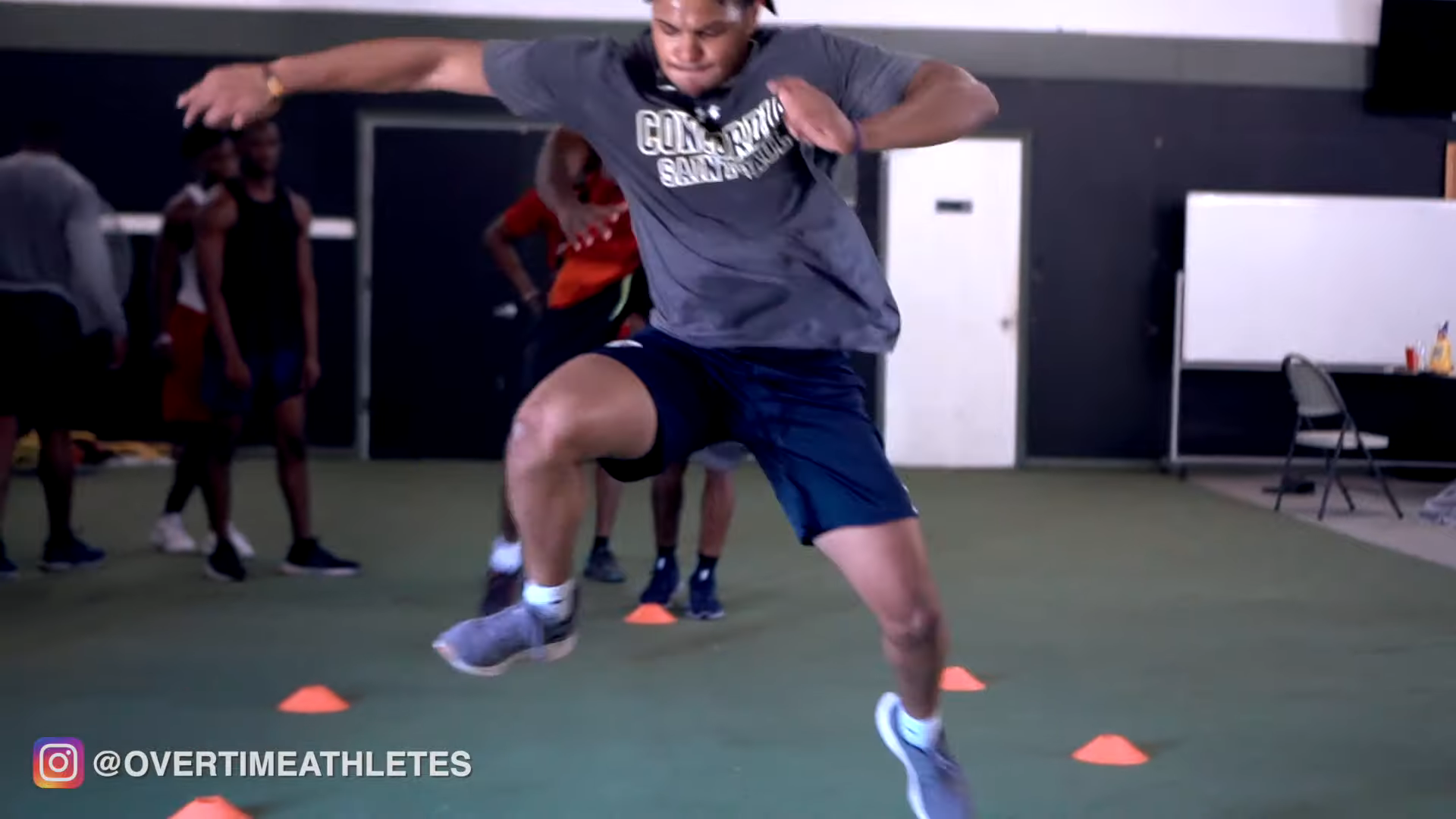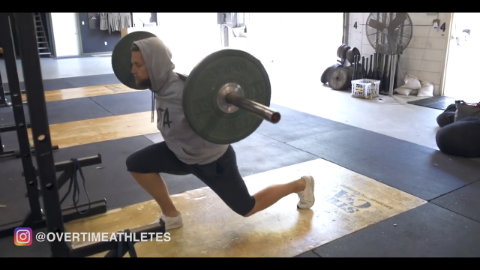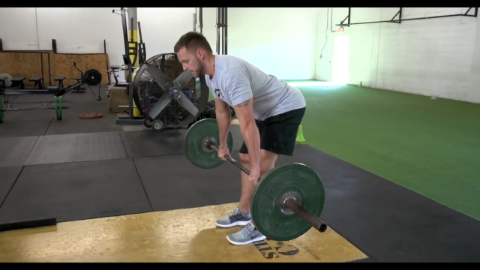How to Jump Higher Off One Foot (Part 2)

Yesterday I wrote a post on how to jump higher off one foot. This is a frequently asked question. And for good reason.
Most times, a hooper or a football athlete won’t have an opportunity to gather both legs under himself and jump off of two feet. But, a lot of athletes feel less explosive, powerful, and stable when they jump off one foot.
In yesterday’s post I shared some ways to stabilize yourself on a single leg and become more explosive off of one leg. Today I want to build on those two keys to jump higher off one foot by sharing how to strengthen your leg.
Not only will this help you remain stable… But it will also help you become more powerful, as strength is the precursor to power.
Let’s get into it:
Strength and Your One Foot Jumping Ability

A big problem most athletes have is they lack foundational strength.
They lack the foundational strength to hold themselves in the right positions statically and ESPECIALLY dynamically. That means when they sprint, jump, cut, or dash, they may put themselves in a compromised position.
And this isn’t a knock on their work ethic.
Many of my athletes return from the offseason detrained due to the stress of the season.
But there are also athletes out there who just dabble in plyometrics and sprints and expect to get faster, jump higher, and become more explosive.
Big mistake.
Because strength is a precursor to power. The stronger you are, the more powerful you’ll become… If you’re developing your strength the right way.
Not only does a lack of strength puts you in a compromised position…
It also puts you in positions that create power leaks.
For example, a lot of athletes have weak glutes. This creates a collapse in the knee when they go to jump.
Weakness like this can also create problems during sprinting, cutting, and other athletic movement.
How to Build Strength That Helps You Jump Higher Off One Foot

In order to build strength that helps you jump higher off one foot, first you need to build a foundation.
You can do this with bodyweight training or traditional strength training.
Here are the parameters you should follow to build a strong foundation:
- Select 3-5 Compound Lifts
- Perform sets of 6-12 reps
- If you’re using lower reps, raise the intensity
- Focus on bend and squat patterns
- Utilize unilateral and bilateral movements
When you’ve established a strong foundation, you can move on to building elastic strength.
Elastic strength is the ability of the muscle tissues to absorb, store, and release energy quickly. Elastic strength is great to have if your goal is power, as power is your ability to produce maximal force as quickly as possible.

There are a few methods you can use to build elastic strength. One of my favorite training strategies for building elastic strength is triphasic training.
The triphasic approach is essentially taking a training block and dedicating it to a specific portion of movement. Your first block is dedicated to the eccentric, or lowering portion.
The second block is dedicated to the isometric, or transition portion.
The final block is dedicated to the concentric or elevation portion.
Each portion of movement comes with its own benefits when you emphasize it, but the point is, building strength with Triphasic will help you become more explosive (you can learn more about this in my free Advanced Strength Course).
Here are the parameters for building strength with triphasic training:
- Start with about 60% of your one rep max when you add tempos
- As tempo decreases, intensity increases
- Use only for your main compound lift
- 3 Weeks On then deload
- Keep reps between 2-5
Accommodating Resistance

Another training method that will help you jump higher off one foot is accommodating resistance. Accommodating resistance is one of my favorite strategies for building strength that seamlessly carries over to power.
Essentially accommodating resistance keeps the tension on your muscles for an entire movement.
As an example, think of a squat.
When the weight is too heavy, you don’t descend as low as you normally would. This is because the higher you squat, the less tension you have on your muscles.
When you add accommodating resistance in the form of bands, you keep the tension on the muscles for the entire movement. This accommodating resistances removes your need to decelerate and allows you to accelerate through the entire movement.
Obviously, this will make you more explosive, if you do it right.
Typically you only see accommodating resistance used with compound lifts like the bench press, squat, and deadlift. However you can also use it with unilateral movements as you’ll see below.
How to Build Lower Limb Strength to Jump Higher Off One Foot

The last thing you need to address in terms of strength and jumping higher off one foot is lower limb strength.
Lower limb strength is something that most coaches overlook due to it being outside of their coaching comfort zone. But, over the years I’ve discovered that many deficiencies are nestled in the lower limb.
I’m talking issues in the hip and knee. A lot of them stem from the ankle.
And if you take time to strengthen the ankle and foot, I’ve found that many times these deficiencies take care of themselves.
Below, I’m going to share a few ways to strengthen the lower limb. I also have a post on lower limb development if you want to go deeper into the subject.
Single Leg Strength Exercises to Jump Higher off One Foot

Now we finally arrive at some single leg exercises you should use to jump higher off one foot.
These shouldn’t be the end all of your workout. They should be included with your plyometrics and big compound lifts.
If you sprinkle them in, I’m sure you’ll find you’ll start to jump higher off one foot.
Monster Walks
Monster walks target the usually weak muscles of the gluteus medius. When you strengthen this muscle you’ll be less likely to collapse at the knee when you jump. You’ll also keep your pelvis stable when moving dynamically.
A few cues for monster walks include:
- Keep the Knees and Ankles Outside of Hip Width
- Keep the Knees and Ankles Stacked
- Take Short Choppy Steps
- Keep the Heels on the Ground
Bulgarian Split Squats

Bulgarian Split Squats are one of the best exercises you can do if your goal is jumping higher off one foot. There are a couple ways you can do them, and they can target different muscles based on your ankle placement. If your ankle is placed behind your knee it puts more emphasis on the quad (if you have bad knees, I advise against this). Place your ankle in front of the knee and you place more emphasis on the glute. And if you stack your ankle and knee you encourage even recruitment of the quads and glutes.
A few cues for Bulgarian Split Squats include:
- Stack the Knee and Ankle
- Push the Hips Down and Back
- Drive Through the Foot
Reverse Lunges (And the Many Variations)

This is a big one. The reverse lunge is easily my favorite unilateral movement for athletes. And in my opinion, I believe it’s the best.
For one, the reverse lunge targets the muscles of the posterior in a way that mimics the position of your body when you accelerate in a sprint. It’s also extremely versatile.
I can do barbell reverse lunges, dumbbell reverse lunges. I can add a box under the athlete to train the movement through a larger range of motion.
Some of my favorite variations for jumping higher off one foot include using accommodating resistance and training the lower limb with dumbbell reverse lunges (shown below).
Some cues for Reverse Lunges include:
- Draw the Shoulders Down and Back
- Keep the Chest Over the Thigh
- Keep Your Weight on Your Front Leg
Single Leg RDL

Here’s another movement that targets the posterior chain. The single leg Romanian deadlift is another movement that I love to help athletes jump higher off one foot. It teaches the athlete how to engage the hip and helps with stability.
These can be performed a couple different ways, but I prefer the method I’m going to share below.
Some cues for Single Leg Romanian Deadlifts include:
- Push the Hips Back
- Pin the Shoulder Down and Back
- Knee is Relaxed
Building Strength For Explosiveness

Above I shared some surface-level info on how to build strength that transfers into explosiveness.
If you want to dive deeper into learning how to build strength that transfers to ALL aspects of athleticism, you can jump into my NEW Advanced Strength Course.
Inside you’ll discover:
- The strength method that allowed my friend to overhead press 405 pounds!
- How to create an athletic strength program for yourself or your athletes
- The BEST strength exercises to use for athletes
And a whole bunch more.
Click Below:
Learn How to Build Strength That Transfers Seamlessly To Your Athleticism